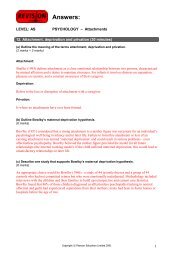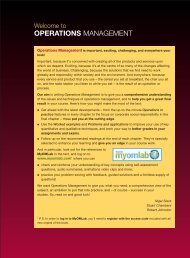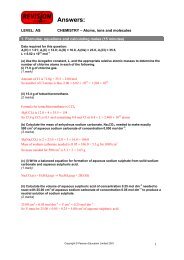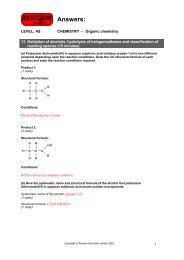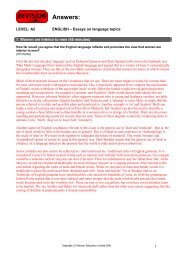The Dove Campaign for Real Beauty - Pearson
The Dove Campaign for Real Beauty - Pearson
The Dove Campaign for Real Beauty - Pearson
You also want an ePaper? Increase the reach of your titles
YUMPU automatically turns print PDFs into web optimized ePapers that Google loves.
Chapter 2 Sustainable marketing: marketing ethics and social responsibilityexpensive cars, the latest (or best) designer clothing and high-tech gadgets. This drive <strong>for</strong>wealth and possessions hit new highs in the 1980s and 1990s, when phrases such as ‘greed isgood’ and ‘shop till you drop’ seemed to characterise the times. In the current decade, manysocial scientists have noted a reaction against the opulence and waste of the previous decadesand a return to more basic values and social commitment. However, our infatuation withmaterial things continues.Between 1960 and 2007 real GDP (inflation adjusted Gross Domestic Product) grew 400 percent in the EU15 and close to 500 per cent in the US. <strong>The</strong> size of the typical new house hasmore than doubled. A family owning a car was once a goal, now it is hard to know where to putthe multiple cars that families own. Designer everything, personal electronics and other itemsthat didn’t even exist a half-century ago are now af<strong>for</strong>dable. Although our time spent shoppinghas dropped in recent years to just three hours a week, our rate of spend in that short time hasexploded. 16<strong>The</strong> critics do not view this interest in material things as a natural state of mind, but rather asa matter of false wants created by marketing. Businesses spend huge sums of money to hireadvertising agencies to stimulate people’s desires <strong>for</strong> goods, and advertisers use the mass media tocreate materialistic models of the good life. People work harder to earn the necessary money.<strong>The</strong>ir purchases increase the output of the nation’s industry, and industry, in turn, uses theadvertising industry to stimulate more desire <strong>for</strong> the industrial output. Thus marketing is seen ascreating false wants that benefit industry more than they benefit consumers.<strong>The</strong>se criticisms overstate the power of business to create needs. People have strong defencesagainst advertising and other marketing tools. Marketers are most effective when they appeal toexisting wants rather than when they attempt to create new ones. Furthermore, people seekin<strong>for</strong>mation when making important purchases and often do not rely on single sources. Evenminor purchases that may be affected by advertising messages lead to repeat purchases only if theproduct delivers the promised customer value. Finally, the high failure rate of new productsshows that companies are not able to control demand.On a deeper level, our wants and values are influenced not only by marketers, but also byfamily, peer groups, religion, ethnic background, education and deep-seated needs that pre-datethe modern age. <strong>The</strong> pre-industrial age 1660–69 diaries of Samuel Pepys, the writings ofDr Johnson (1709–84) and Jane Austen’s (1775–1817) novels are littered with products thatwere desired and bestowed status. Also within Bronislaw Malinowski’s seminal work on fieldanthropology is the realisation that people’s status was based on jewellery traded across thePacific islands. <strong>The</strong> roots of our modern materialistic societies are much deeper than businessand mass media could produce alone. Dr Johnson even decoded and classified ‘puff’, meaningexaggeration, in advertising and selling. 17Too few social goodsBusiness is accused of overselling private goods at the expense of public goods. As private goodsincrease, they require more public services that are usually not <strong>for</strong>thcoming. For example, anincrease in car ownership (private good) requires more roads, traffic control, parking spaces andpolice services (public goods). <strong>The</strong> overselling of private goods results in ‘social costs’. For cars,the social costs include excessive traffic congestion, air pollution, fuel shortages and pedestrianinjuries from car accidents.81




